Interview with Alan Kemp about the Martial Eagle in Southern Africa
 I first met Alan years ago when he was the curator of birds at the Pretoria Museum. I was just beginning field and museum work on the African raptor field guide. After a few days of studying raptor specimens, Alan invited me to join him for a week of field work in Kruger National Park. Alan had already published many articles reporting his extensive raptor field work. During this week I was able to learn a great deal about African raptors from him, as well as study and take photos of them in person.
I first met Alan years ago when he was the curator of birds at the Pretoria Museum. I was just beginning field and museum work on the African raptor field guide. After a few days of studying raptor specimens, Alan invited me to join him for a week of field work in Kruger National Park. Alan had already published many articles reporting his extensive raptor field work. During this week I was able to learn a great deal about African raptors from him, as well as study and take photos of them in person.
Alan was born and raised in Zimbabwe (then Rhodesia) and has always been interested in natural history, including practicing falconry. He received a PhD at Rhodes University, South Africa and first worked on raptors for and with Dr. Tom Cade for three years in the Kruger National Park. He later spent 32 years as ornithologist and curator of birds at the Transvaal Museum in Pretoria, South Africa. He and his wife Meg coauthored ‘Birds of Prey of Africa and its Islands,’ a mini handbook still in demand. Since retiring from the Museum, he has worked as a wildlife consultant. His main research interest is hornbills in Africa and Asia, but he has always included studies on raptors wherever possible, including recent raptors surveys in South Africa.
I have had the good fortune to spend much time with Alan over the years, both field and museum time, and every such time I learned more about African raptors. I’m sure that you and I will very much enjoy this interview.
Bill Clark Harlingen, Texas USA
All images in this interview taken by Alan Kemp or Keith Begg.
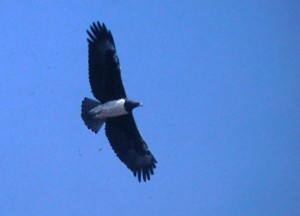
1) What is known about the current status of the Martial Eagle in South Africa and other countries?
The Martial Eagle is designated as Near Threatened in the 2011 IUCN and BirdLife International Red List over its total African range of c. 750 000 sq.km, but as Vulnerable in the official South African Red Data book. There is also concern for the species in Zimbabwe and Swaziland.
2) How has the population developed over the last decades?
I am only familiar with the status of the species in South Africa, where it has declined over the last few decades, not obviously in range but probably by about 20% in numbers. It occurs naturally at low densities, but in some areas it is now rare or absent.
3) Is there a difference between protected areas and non protected areas?
Within South Africa and Botswana there is evidence that it is recorded more in large conservation areas than in unprotected areas, most notably in the Kruger National Park and the Kgalagadi Transfrontier Park within South Africa.
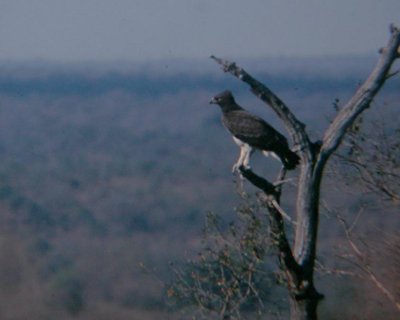
4) Is persecution still a serious problem for the Martial Eagle?
Persecution, direct and indirect, is still a cause of mortality in South Africa and Namibia, especially in areas of small livestock (sheep, goat) and game farming. Direct shooting and trapping, and indirect poisoning appear to be the main factors, but various education and awareness programmes in South Africa are having an effect in some areas.
5) How does electrocution affect Martial Eagles? What can be done to reduce mortality?
Electrocution is a cause of mortality in South Africa, but probably not a major one. Lower voltage rural lines, with the live wires close enough together to be touched simultaneously by such a large eagle, are the main culprit, but some of the deaths also result from collision with the wires. At the same time, the tall pylons supporting high voltage lines offer nesting sites in more open habitats. The national electricity supply agency works closely with conservation NGOs to rectify problems and encourage safe nesting. Problems with power lines are expected to be less in less developed countries with fewer supply lines.
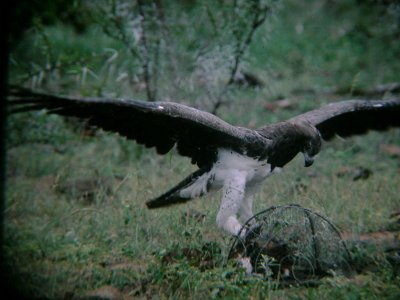
6) What other threats do exist for the Martial Eagle?
An import threat, especially in drier areas, is drowning in open water reservoirs. This can be avoided by floating an exit structure (ladder, log) to enable birds to clamber out of the sheer walls, but requires the necessary education and awareness of landowners. Martials can live for long periods without drinking, although they do sometimes drink and bathe when water is available, but most drownings occur in arid areas where the need to drink or bathe may be more frequent.
Despite all these known causes of mortality, the primary threat to this large eagle in South Africa, and probably elsewhere in Africa, is almost certainly conversion or reduction in the prey-carrying capacity of its favoured habitats. Conversion of land to agricultural crop- and pasture lands, or to dense small-hold and residential areas, effectively excludes the species, while extensive herding and ranching lowers the carrying capacity of natural prey animals, especially when stocking rates are excessive.
7) What is the preferred habitat of Martial Eagles?
The most favoured habitats are open savannas, with a mix of indigenous trees, large and small, bushes and areas of open grassland. Such a diverse mosaic of plant forms, and the ecotones they produce, support both a high diversity and density of prey species. Martials extend readily into more open semi-desert habitats, and even into desert along wooded watercourses, but at a lower density. Wherever they occur, they require large trees (or pylons) as nest sites. They do not occur in more densely wooded habitats, such as parts of Mozambique and Tanzania, nor in forest habitats (where the large African Crowned Eagle is most common), and it generally avoids very broken terrain (where Verreaux’s Eagle and its main hyrax prey predominate).
8 ) What is the main food of Martial Eagles?
A wide variety of animal prey is captured by this large and powerful eagle, predominately vertebrates of 1-4 kg in mass, with the most frequent items varying from region to region depending and availability and abundance. Gamebirds, viverrids, squirrels and large lizards are often important prey items, but birds as large as Kori Bustard, mammals as large as young warthog, impala or baboon, and monitor lizards are taken at times. Most individuals do not take livestock, even in farming areas.
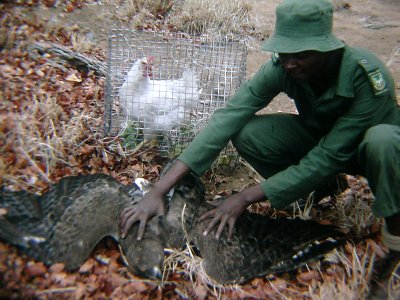
9) Do Martial Eagles compete with other raptors for food or nesting places?
Martials often occur in habitats that support a variety of other predatory birds, especially in extensive areas of natural habitat and/or conservation protection. Their main competitors of similar size are usually separated by habitat preference, such as African Crowned Eagle (forest), Verreaux’s Eagle (rocky habitats, cliff nesting) and African Fish-Eagle (waterways), or by hunting behaviour (Secretarybird, Ground-Hornbills) but where their ranges overlap there are sometimes competitive encounters, mainly about prey that one or other species has flushed and/or captured.
Other predatory birds that interact with Martials include those that regularly pirate prey (Tawny Eagle, Ground-Hornbills), and those that sometimes take over their vacant nests (various eagle and vulture species).
In general, Martials are the largest, strongest and best-adapted predator in this preferred habitat, and so competition is usually low.
10) What is the typical hunting technique of Martial Eagles?
Martials hunt from a perch, usually in a tree but sometimes on a rock or even on the ground. However, their main hunting technique, making use of the long broad wings and expert soaring ability, is to soar over their extensive home range and then descend on prey spotted below, either in a long shallow dive or, less often, a steep fast stoop. Rarely hover during strong winds when hunting, but much less so than the similar-looking Black-chested Snake-Eagle. Sometimes lands after an abortive strike, and then waits at perch for a second chance. After killing large prey, may perch nearby and return at intervals to feed, exceptionally for five days.
11) Do Martial Eagles also feed on carrion?
They will pirate prey from other predators and even come to feed on carrion, but not on a regular basis. Some of the instances reported as livestock kills are known to be actually attraction to carrion.
12) How often do Martial Eagles breed and how many eggs are usually laid? Do sometimes more than one chick fledge?
A Martial Eagle female only ever lays a single egg per clutch and so raises only a single chick at a time. Laying commences usually during the driest season (e.g. April-June in southern Africa), and pairs often attempt to breed in successive years. As many as one 30-50% of pairs may not breed in a given season,because conditions are unsuitable and/or a juvenile is still being raised, and overall pairs fledge on average about one chick every two years. The long nesting cycle (c. 50 days incubation, 100 days nestling, 3-4 months post-fledging dependence) means that nesting starts when prey visibility is best and continues into summer when prey numbers are highest.
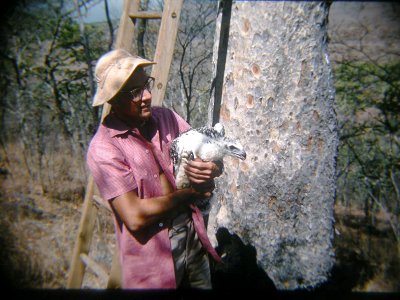
13) What is known about the dispersal and movements of Martial Eagles, especially the juvenile birds?
Adult breeding pairs appear to be resident and sedentary once they have established their large territories (c. 150 sq.km in wooded savanna to 250 sq.km in semi-desert). In areas of good-quality contiguous habitat there may be few dispersal sites for juveniles/immatures during the c. 6 years before they attain mature plumage (as in several large conservation areas), and so they wander widely (although exact details are sparse) and predominate in accidents in what are probably less productive marginal habitats.
14) What natural enemies do Martial Eagles have, for example can Leopards or Baboons be a threat to the young in the nest?
Being so aerial, large and powerful, for Martials few instances of predation are reported, even at nests, and most known mortalities are due to accidents. Baboons are diurnal and likely to be driven away, but leopards are nocturnal and might surprise and adult/chick on the nest. Most nest failures by known ‘predation’ involves egg- and/or chick-collectors, or other human persecution.
15) Do you know of any conservation projects for the Martial Eagle?
There have been several field studies of Martials in South Africa, Namibia, Zimbabwe and Kenya that I am aware of, mainly in large conservation areas but also in livestock and other farming areas. These have supplied some of the details on biology that are necessary to organise effective conservation management strategies, but in the end depend on the priorities and will of the residents of the countries within the species’ range. I am not aware of any comprehensive current projects that specically target this species.
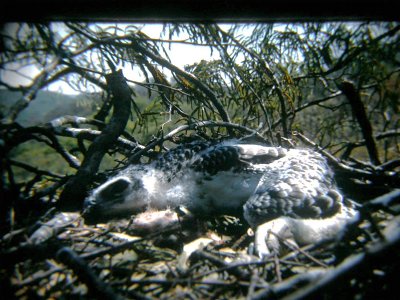
16) What should be done to secure the future of Martial Eagles in Africa?
The primary effort to secure the future of this species in Africa is to maintain as many large areas of pristine, or near-natural habitats as possible. These would supply a productive basis for the population as a whole, and probably ensure that increased mortality from various anthropogenic effects do not precipitate a general decline. In practise, this requires local conservationists to secure and protect whatever natural habitat they can, within the realities of the human requirements within their region. How this is achieved in the face of human populations growing in size, affluence and ambition, and divided into diverse ethnic and political units, remains the real challenge.
17) What other raptors would benefit from such conservation measures?
African savannas support a high diversity of raptor (and other animal and plant) species, so ensuring the protection of viable populations of an eagle with such large spatial requirements as a Martial Eagle will inevitably protect a high level of biodiversity. For example, in the 20,000 sq km Kruger National Park of South Africa (now doubled in area as a transfrontier park) there are an estimated 130-150 breeding pairs of Martial Eagles, among a total raptor community of c.70 recorded species, and where, with luck, one can see 26 species in a single day.
18) What was your most amazing experience with Martial Eagles?
While I was busy ringing a large Egyptian gosling near a small dam, an adult female Martial Eagle passed high overhead at a height of about 200 m above ground. I released the gosling once the eagle was at least 1 km away and, as it waddled off to the water, the eagle banked, made a long 2-part stoop, first away and then back, and ended with a rushing attack just as the gosling reached the safety of the water. The distance at which it spotted the potential prey, the rate of its attack, and the spectacle of the near-miss at close quarters was unforgettable.

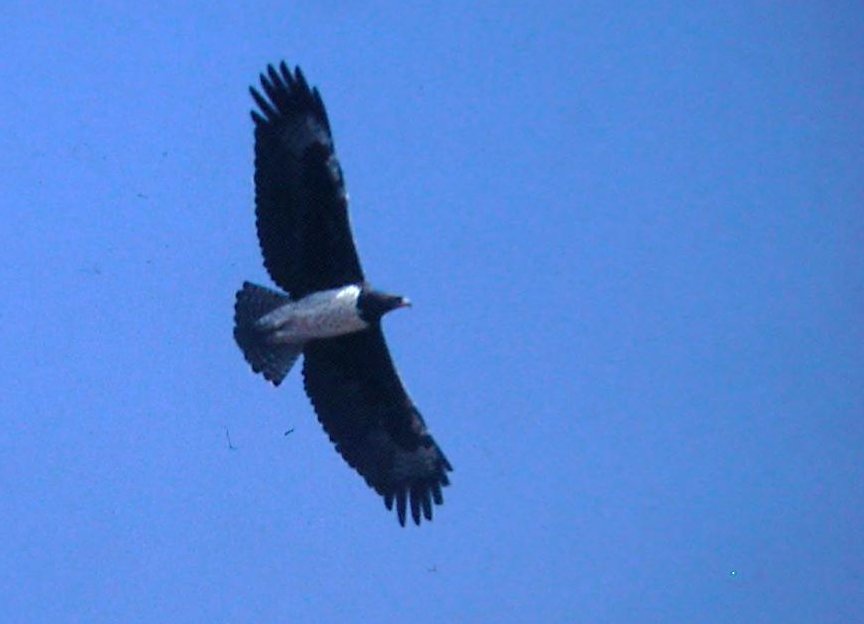
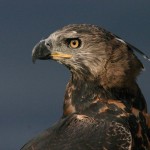
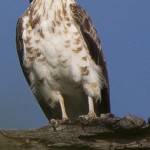

Another question:
The wind energy gold rush is starting now to carpet-bomb big area’s in the windy places of South Africa. World wide Eagles are in air-space competition with the massive industrial wind turbines and little of this is put out in the public.
How will this influence the population of these birds and what can we do to protect them.
I would like to write directely to Mr. ALn Kamp.
Any e-mail adress ?
Many Thanks
Through the 30 years of my career, I once in a while did fieldwork in the Nilgiri Mountains of southern India. Wonder now if Amur Falcons might in their migrations cross these mountains on their way to southern Africa. Thus I look forward with the greatest anticipation to forthcoming data revealing their southward routes to South Africa.
Bill Noble
The reference to point 18 about the eyesight of the Martial is interesting. About 20 years ago I placed a Bal-chatri trap with a single mouse to trap a Martial perched on a telephone pole in the Karoo near Graaff Reinet. The bird sighted the mouse and came in from a distance of at least 400m. Their eyesight is astonishing. All Martials I have ringed have been trapped with white mice and have had good success with this prey item.
Hope you are well!
I have been working on ancient rock art for some time and I am having with two species. May I a end you images?
All best wishes
Gerry
[…] – Nelspruit News A young martial eagle attempting to take on a klipspringer (amusing) Interview with Alan Kemp about the Martial Eagle in Southern Africa (including the global problem of electrocution) (American) Bald Eagle Electrocuted Shortly After […]